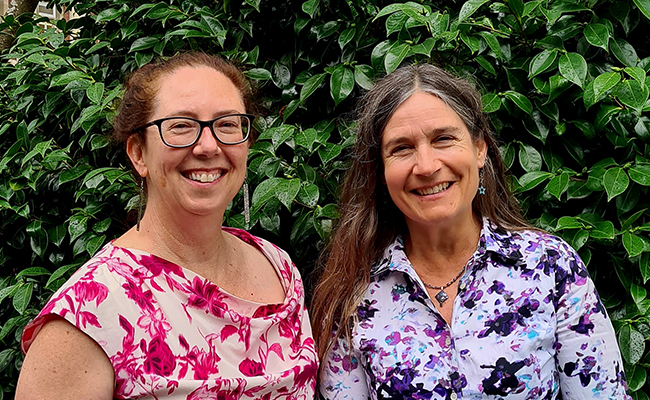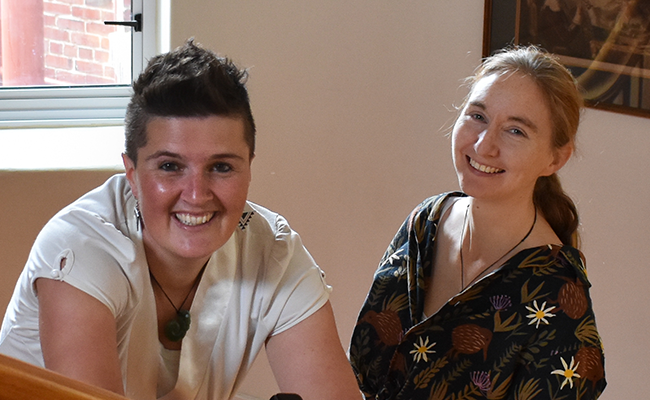Wednesday 22 March 2023 4:07pm

Anatomy department leaders Professor Louise Parr-Brownlie (left), Deputy Head of Department Māori, and Professor Christine Jasoni, Head of Department.
The importance of acknowledging and accepting Tiriti-partnership is a key motivation in Te Tari Kikokiko (Department of Anatomy), having recently adopted a raft of structural, curricular, and operational changes embracing Te Tiriti o Waitangi.
Changes include the requirement for all undergraduates to complete a Māori-focused paper as part of their Anatomy major subject requirements, something that the department feels will equip students with cultural competency and knowledge.
Head of Department, Professor Christine Jasoni says her goal when she started as Head of Department in early 2022 was the department to move confidently in the direction of being Te Tiriti-led and responding to the goals of the University's Māori Strategic Framework.
“Strategic adaptation takes time, so it was important to send some early messages of intent using a few early wins to form the foundation on which to build across, “she says.
“The first was to assert the importance of co-leadership and partnership and so we created the position of Deputy Head of Department Māori, appointing Professor Louise Parr-Brownlie (Ngāti Maniapoto, Te Arawa) to the role.
“The department is fortunate enough to have various Māori subcommittees including Māori ki Anatomy, Rōpū te mea Māori and the Anatomy Māori and Pacific Tauira Support Network. These act as forums for staff and tauira to influence and advance Te Tari Kikokiko within te ao Māori.
“The amalgamation of the subcommittees formed Te Kōmiti o tā Te Tari Kikokiko Pou Tarāwaho Rautakitanga Māori (The Māori Strategic Framework Committee of the Department of Anatomy). Which acts as a pou or pillar coordinating, facilitating, and supporting activities consistent with implementing the Māori Strategic Framework.
Prior to 2023, it was optional for students to select a Māori paper as part of their degree. However, the Anatomy Department, through Professor Jasoni’s leadership, appreciated the value of equipping graduates with cultural knowledge and competency within Te Ao Māori.
“The most extensive implementation was making a Māori-focussed paper compulsory as part of an Anatomy major undergraduate subject requirements. Whilst most supported this implementation, it still surprised me that some chose not to support it at multiple levels. But hesitancy to change is to be expected,” says Professor Jasoni.
“The tautoko from Departments and Centres throughout the University who teach Māori-focused content, including Te Tumu, Kōhatu, and the Departments of Physical Education and Public Health, has been huge when it comes to providing resource.”
In addition, they introduced Māori Health Advancement and Vision Mātauranga training for 400-level students alongside a new requirement for these students to include an assessed Māori Health Advancement or Vision Mātauranga statement into their theses on how their research will benefit Māori.
There are many motivators for the American-raised Professor Jasoni, but empowering Māori to thrive in spaces where Māori students have been disadvantaged is key.

Subcommittee Rōpū co-leaders Dr Alana Alexander (Ngāpuhi: Te Hikutu, Pākehā), left, and Dr Charlotte King are providing support within the department.
“Our educational systems have traditionally disadvantaged Māori for many reasons. I believe strongly that Māori should not have to stop being Māori in order to be successful in our university system and in their careers beyond university.
“It’s about creating a learning environment where Māori staff and students feel safe and can pursue their learning and academic aspirations in a culturally relevant and supportive environment without feeling pressure to change who they are in order to be successful. That meaningful rather than transactional relationships between Māori and non-Māori eventuate in our teaching and research practice.”
While the changes have been quick to implement, there has undoubtedly been some challenges to overcome, including resistance to change, she says.
“There is a poor understanding of what equity means as well as the fear of the unknown. Over the year, buy-in has increased as people became more comfortable, mainly with tikanga and using te reo Māori.
“I feel it is vital to point out that I am incredibly fortunate to have a number of Māori staff who are engaged and eager to give their time and invest in this kaupapa, alongside a number of tangata Tiriti allies who partner in most of the committee undertakings.
Māori tertiary education staff are few and far between. A plan of succession has also been developed and adopted called ‘growing our own.’
“The biggest challenge now is to leverage on the mahi we've already done and keep moving forward.
“One of our new initiatives, which I am quite excited about is a ‘grow-our-own’ succession plan to bring Māori and Pacific students through postgraduate study and into becoming academic staff in our department.
“The plan begins with an equity programme for admission into postgraduate study, which will be available for both Māori and Pasifika students. We are developing a course of study at 400-level that will capitalize on indigenous knowledge and perspectives which we hope will create learning environments where we know our Māori and Pacific students do well.
“That way the programme supports students so that those admitted on equity grounds are not set up to fail in our current system. We must enable these students to thrive.
“Ultimately, it is my goal for our Māori students to find their passion and celebrate being Māori within our academic context, whilst playing to their strengths.
“If we don’t embrace change, we will forever play catchup and our tauira will continue to not have their competencies valued or seen as beneficial, as is presently the case in our Western context.
“I am hopeful that from the changes we have made in Te Tari Kikokiko, that we are able to whakamana (empower) similar moves across the University of Otago, and wider.”
Kōrero by Keanu Flavell, Kaiārahi Pāpāho Māori / Communications Advisor Māori
The implementation overview toward a Tiriti-led Anatomy Department:• Creation of a new senior leadership role, Deputy Head of Department Māori, and appointment of Professor Louise Parr-Brownlie
• Implementation of a new degree requirement for all students majoring in Anatomy to take a Māori paper
• Introduced Māori Health Advancement and Vision Mātauranga training for 400-level students
• Introduced requirement for 400-level students to include a Māori Health Advancement or Vision Mātauranga statement into their theses, which is marked and contributes 5% of their final grade
• Introduced new guidelines for staff and students who want to engage with Māori communities and researchers, in order to build relationships meaningfully and ensure a culturally safe environment
• Proactive equity hiring – the department currently has five Māori academic staff
• A Rōpū te mea Māori to provide a supportive environment to support upskilling by tauiwi in the department in all aspects of te ao Māori, including regular te reo instruction, waiata practice, tikanga and mātauranga Māori
• A rōpū Māori ki Anatomy to support Māori staff and postgraduate tauira within Te Tari Kikokiko
• The Anatomy Māori and Pacific tauira support network facilitating activities that support Māori and Pacific tauira
• The establishment of an over-arching committee, Te Komiti o tā Te Tari Kikokiko Pou Tarāwaho Rautakitanga Māori (Māori Strategic Framework Committee of the Department of Anatomy): This committee coordinates, facilitates and tautoko activities consistent with implementing the Māori Strategic Framework, including supporting the activities of Māori ki Anatomy, The Anatomy Māori and Pacific tauira support network, and Rōpū te mea Māori.